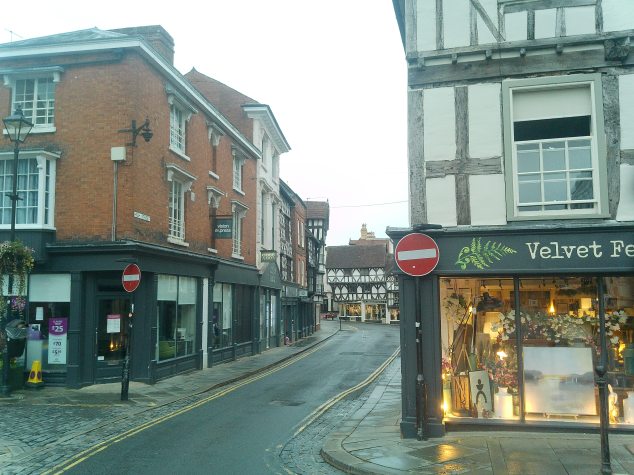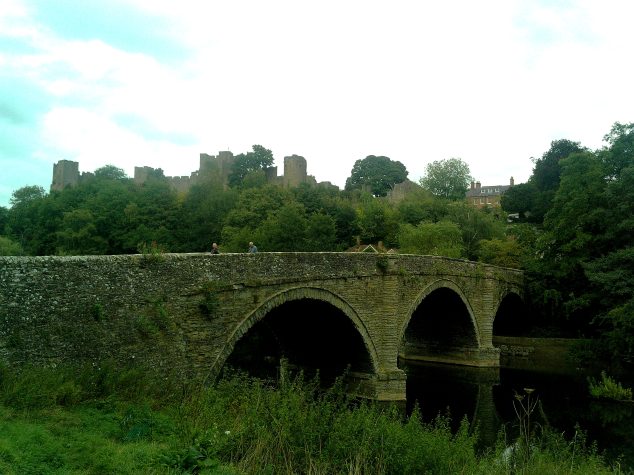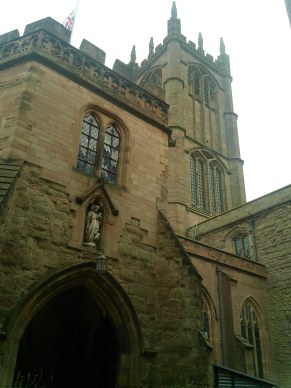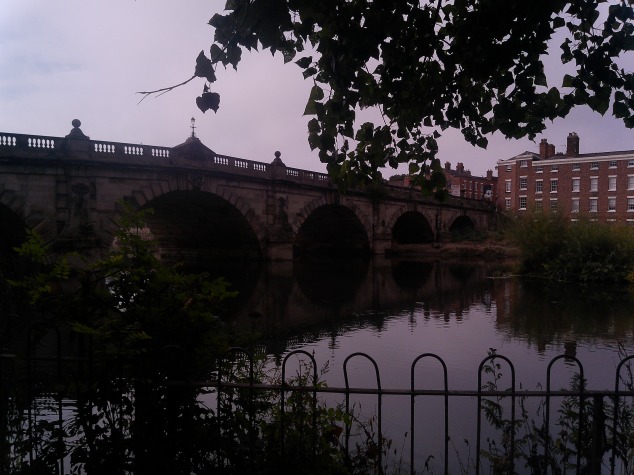
The English Bridge, Shrewsbury
My first thought about this Shropshire town is comparisons, so let me make them first.
I said that Chester is black and white and red all over; the same is true for this other Welsh border county town of c70,000, except that the Salopian one includes beige. But then I looked at Chester and counted at least 8 major central buildings (the new castle, old news room, Bridgegate arch, St Michael’s church, Brown’s department store, the town hall, a couple of banks) that are also made of that stone. But I note that in Chester, they’re all within 100 years from the late 1700s; whereas in Shrewsbury, they start earlier – in medieval churches and late Tudor school and market hall, as well as the Victorian railway station. oth these Marches mediaeval gems are thus built in a limited and distinctive colour scheme, a defining feature and an easy fact in popular imagination. The truth is that along with local stone, they are filled with brick frontages of a similar hue – a reddish pink – and that Georgian (or what appears to be) is as much part of their character as the older timbered buildings. Chester’s set of the latter involves more neo and restored edifices; both showcase the West of England patterning. Rather than just vertical studs, here the timber frames involve squares to be filled in with quatrefoils and diagonals, curves, cusps and clubs (of the playing card kind). In Shropshire there are a few of these 15-17th C houses which preserve the natural dark brown of the wood, instead of painting it black, and that the plaster inbetween can be a bright yellow, such as Castle Gates House currently sports.
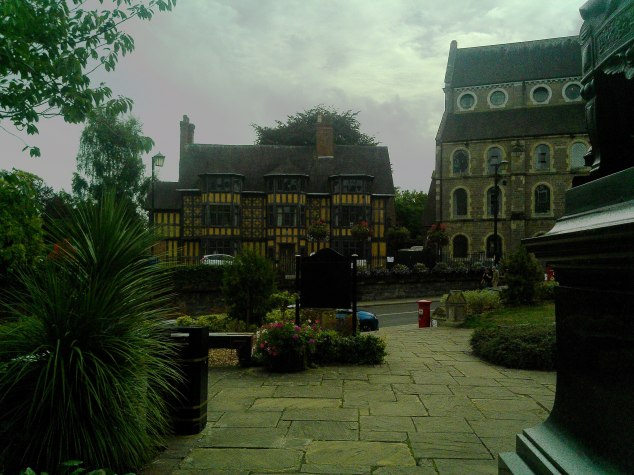
Castle Gates and St Nicholas’ chapel from the library and you-know-who statue
Both are on a loop in the river, but Chester’s coils are often off central maps. Shrewsbury’s horse shoe lends itself to logos, whilst Chester is defined by the shape of its largely extant walls, which is a rectangle with a bite out of one corner. Thus one is delineated by straight lines and an almost basic geometric shape, but Shrewsbury’s central footprint is free flowing and curvy.
Both have Georgian bridges, and elegant iron footbridges; a park between river and town wall; a market square; a truncated major Norman church just outside the walls; and a Georgian-interfered with castle.
And both have a classy historic air.
Even their universities are joined – the arms of University College Chester shares the wall of its Salopian counterpart on the quay of the latter. And they’re joined by a railway line – and why wouldn’t a resident or visitor of one wish to go to the other, since they are so alike?
The biggest difference is that Chester is essentially Roman; its four main streets meet at a cross. Chester is about wide, easily navigable street pattern, but Saxon born Shrewsbury is about lanes and ‘shuts’. I oft consulted my map, even on an extended stay, which wasn’t my first visit.
Chester has the Anglican cathedral – making it the only city of the two – but otherwise Cestrian churches aren’t much in my consciousness. Shrewsbury has less parish churches in the middle, but the four feel like more of a feature. Shrewsbury’s Catholic cathedral is not a memorable edifice. It is close to the only stretch of town walls – another key difference between these places, for Chester’s Walls are one of its most famous features, and Shrewsbury has no Rows. And Shrewsbury doesn’t have a grand town hall, whereas Chester lost its old market hall on legs.
Other than that, I think their offerings are similar. For me, Shrewsbury isn’t a place to go to see anything in particular, although I loved the town’s free museum. It used to be in Rowley’s House, but is now housed in a music hall and a medieval mansion called Vaughn’s off the Square. I had very pleasant experiences each time I popped in. It is also the visitor information centre.

Shrewsbury Abbey
Fans of Cadfael – the medieval murder mystery solving monk invented by Ellis Peters – will be glad to know that he features under the timbers of this mansion, and you can still purchase a trail booklet, but the Quest attraction about recreating his mysteries shut 20 years ago. The site includes the ultra-claustral (have I invented that?) remains of the abbey, severed from its church by a road. It’s open during weekday day times as part of the Shropshire Wildlife Trust, but you’d need to attend a conference to enter the what’s known as the old infirmary, or in the Quest days as the Scriptorium (above) – the building may be neither. It’s unclear what’s built in pastiche and what belongs to the monastic era. The refectory pulpit – a gem of Chester – is an odd piece of statuary in a carpark here, next to what was once a second railway station.
Along with its vast Gothic railway, sprawling over the Severn, Shrewsbury has some industrial heritage – a pumping station in nearby Coleham, and an iron framed flax mill further out at Ditherington. On my visit, the former was in scaffolding and it didn’t open for Heritage Open Days this year; the same is true of Rowley’s House, the brick and timbered merchant’s premises of c1600. The Mill and Maltings has a cafe and exhibition but is at least a mile’s walk from the centre.
Chester too has an industrial heritage and claims a world first in its shot tower.
Despite Shrewsbury’s apparently Tudorliness, the pervasive atmosphere that I was left with was a 19th century son and his school. As one comes up the hill from the train, passing the emasculated castle, you are struck by a late Elizabethan building. Now the town’s library (along with timbered Rigg’s Hall), the pair was once Shrewsbury’s celebrated school. One alumni is feted: Charles Darwin. His statue is outside, watching this sloping major thoroughfare, as if a kind of gatekeeper as much as the castle’s. His old school, now across the river at Kingsland, is as imposing as a Churchill related dubious office block in Chester. It was built as an abusive children’s institution. No, Dorothy Nicole, author of Shrewsbury in 50 Buildings – being of its time does not excuse the kidnap involved in taking kids off London’s streets and bringing them here to be trained to work in Northern mills. That is exploitation, whatever the era or culture. Hence it has an institutional air to this day, although the young people rowing through peaceful gardens gives it an Oxbridge veneer. The only road crossing from the centre, other than the Welsh and English ones, is a cunning toll bridge that no map warned about. To whom is this 20p going? Surely this suspension bridge was paid for years ago? There is a sense of snobbery and paying for the privilege here.
The shopping centre named for Darwin takes up a huge slice of the town centre. When you realise that Shrewsbury old town was somewhat smaller than the river loop, due to being surrounded by gardens as well as wall and water, it strikes one just how intrusive this indoor mall is. I wonder what was there previously? All modern buildings claim to nod to Shrewsbury’s signature look: the jetties, the vertical lines connoting timbering, and this shopping centre also uses red brick. The next most shocking is the 1960s new market hall, the most obvious vertical building in Shrewsbury. I’ll speak of the old one in my other blog, since it’s the town’s only central cinema.
I enjoyed discovering some lesser known buildings, often by shopping and eating. Did you note that the awfully fronted 2 Pride Hill, currently snack bar Pret A Manger, has a medieval stone hall at the back? (This recalls Katie’s Tearoom of Chester). Or that CStores cafe at 8 Milk Street has panelling and a balustrade to a timbered (but staff only) upstairs? And that several Georgian fronts bulge with the secret of something much older? St John’s Hill is the best C18 road, with a particular house named Hardwick (after a certain Bess, countess of here, from Derbyshire?)
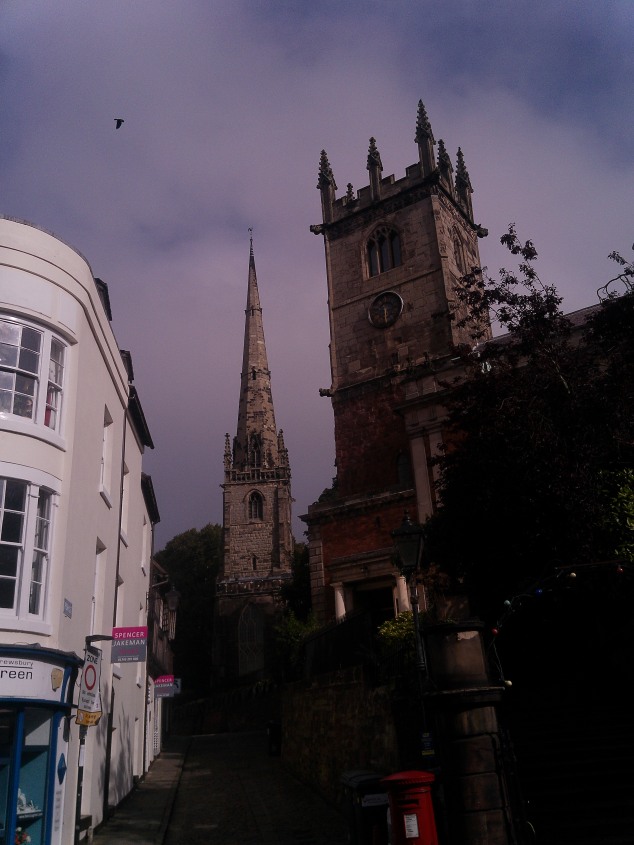
Have I got time to comment on the Georgian treatment of three of the four old parish churches, especially the round one (St Chad’s – what is really going on with that shape?) Or medieval St Mary’s, now cared for by the Churches Conservation Trust, with its bullying billboard – fund or lose it? Or the Unitarian chapel, which isn’t really from 1662, but early 1700s (faced in the 1880s).
I enjoyed finding some ancient enclaves beyond the horse shoe, some of which are mentioned in Cadfael. Frankwell considers it self funky; it’s not a long road, but it contains some older buildings and clearly some night and day life. The Abbey Foregate has some too, and to a lesser extent, Coleham.
The thing I miss – other than that Quest – is the only museum I was able to visit on my first ever trip here. It started to be comical: Rowley’s was closed on a Monday; the craft centre in St Julian’s had moved – we couldn’t find where to; the abbey was shut for a funeral; we went up to the Quest to find that it had ceased trading. So what could we do on a wet day, if we weren’t into military museums (which might have been closed too)? Go to Mythstories.
It seems that this area is rich in traditional stories, and these are collated and celebrated by Dez and Ali Quarrell. I realise now it was aimed at children, but I recall Ali singing enthusiastically along to a CGI duck, and us playing a board game with her which involved at least talking about rollerskates. What could we do – be embarrassed or embrace? We chose embracing and had a lot of fun. The highlight was, on entering what seemed to be an empty room, Dez – with a profusion of grey hair and bright garb – leapt out from a secret door and told us a story, physical theatre style (not that I knew the term then) about the origin of traditional simnel cakes. I will confess that we slithered off after this – the excitement was too much. Yet I looked up the attraction when we got back and printed off portraits of the duo who were displayed on my fridge for some time.
And I recall this, over twenty years on! It might be my most memorable museum visit ever.
Mythstories removed themselves from near the Welsh Bridge to Wem for nearly two decades. I was delighted to learn that they were back in the county town…but then that the collections, now on Frankwell Quay, were dispersing and there was no longer a site for the public to visit. Damn!!
I think my enduring memory is then of stories – both those penned by Edith Pargetter (Cadfael’s creator’s real name) – and those on the origin of cakes. The origin of species is a topic for another time, but I wonder what it says that in a leading town of over a millennia, with a school for half a millennia, why one person who didn’t write stories (although he did tell a narrative) is posited so predominately. You will guess that my Darwin thoughts are as salmonesque as many others.
Lastly: darkness. The passages such as around Fish Street/Bear Steps which give so much pleasure by day feel quite different by night, and I assert (with some local back up) that the council turns the lights down as the night goes on, and then – OFF at least in some residential areas. This is dangerous, and a curfew by stealth in the name of money and planet saving. It made me quickly feel that Shrewsbury wasn’t somewhere to linger longer (I’m thinking of the Cranberry’s song), as much for the council, and the bossy Welsh trains, who are clearly trying to avenge the centuries that Shrewsbury administered to their land by now nanny stating this one.

